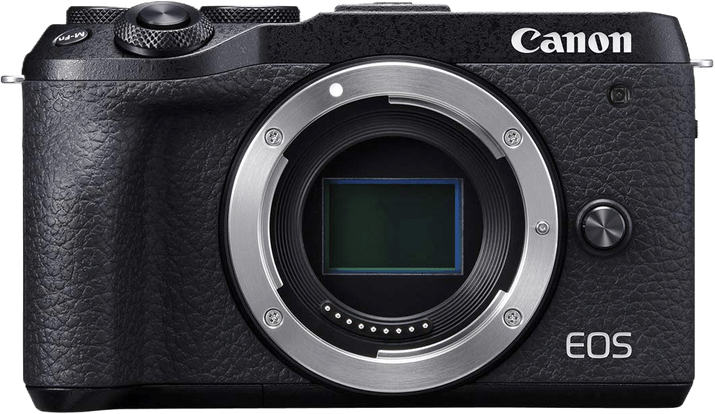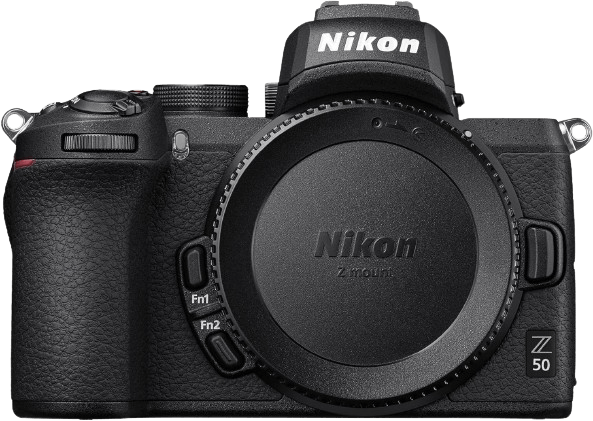Canon EOS M6 Mark II vs Nikon Z50 Comparison
Canon EOS M6 Mark II

Nikon Z50

The Nikon Z50 emerges as the winner with a score of 73/100, while the Canon EOS M6 Mark II trails behind at 63/100. Both cameras are mirrorless and were released in 2019, with the Nikon Z50 announced on October 10th and the Canon EOS M6 Mark II on August 28th. Their launch prices are similar, with the Nikon Z50 at $859 and the Canon EOS M6 Mark II at $850.
The Canon EOS M6 Mark II has a smaller size (120 x 70 x 49mm) and is lighter (408g) compared to the Nikon Z50 (127 x 94 x 60mm, 450g). This makes the Canon EOS M6 Mark II more portable and easier to handle. However, the Nikon Z50 scores higher due to its superior features and performance, making it a better camera overall.
Both cameras have their advantages, but the Nikon Z50’s higher score reflects its better overall quality. The Canon EOS M6 Mark II is a good choice for those prioritizing portability, while the Nikon Z50 is the winner for users seeking better performance and features.
Canon EOS M6 Mark II vs Nikon Z50 Overview and Optics
The Nikon Z50 surpasses the Canon EOS M6 Mark II in optics with a score of 72/100, compared to 62/100 for the Canon model. Both cameras share some common specifications, including a CMOS sensor, APS-C sensor size, and the absence of image stabilization. Additionally, both cameras have unique lens mounts, with the Canon using the EF-M mount and the Nikon utilizing the Z mount.
The Nikon Z50 takes the lead with its superior DXOMARK sensor score of 97, significantly higher than the Canon’s 58. This difference indicates that the Nikon Z50 has a better sensor performance, which contributes to the overall image quality. The Nikon Z50 is also equipped with the Expeed 6 processor, which is known for its fast and efficient image processing capabilities.
On the other hand, the Canon EOS M6 Mark II offers a higher megapixel count of 33, compared to the Nikon Z50’s 21 megapixels. This allows the Canon to capture more detail in images, which can be an advantage in certain situations. Additionally, the Canon EOS M6 Mark II has a faster shooting speed of 14 frames per second, compared to the Nikon Z50’s 11 frames per second, making it better suited for capturing fast-moving subjects.
While both cameras have their strengths, the Nikon Z50’s superior sensor performance and efficient image processing give it an edge in optics. However, the Canon EOS M6 Mark II’s higher megapixel count and faster shooting speed may still appeal to some users, depending on their specific needs and preferences. Ultimately, the choice between these two cameras will depend on the individual’s priorities and requirements in terms of image quality and performance.
Canon EOS M6 Mark II vs Nikon Z50 Video Performance
The Canon EOS M6 Mark II and the Nikon Z50 are equally strong contenders, both scoring 91 out of 100 in video capabilities. They share several video specifications, including a maximum video resolution of 4K, dimensions of 3840 x 2160, and a maximum video frame rate of 120fps. Additionally, both cameras offer built-in time-lapse functionality.
Despite having equal scores, the Canon EOS M6 Mark II has some advantages over the Nikon Z50. One of these advantages is the Dual Pixel CMOS Autofocus system, which allows for faster and more accurate focusing during video recording. This feature can be particularly beneficial for vloggers and content creators who require smooth and precise focusing.
On the other hand, the Nikon Z50 also has its strengths. Notably, it features a more robust weather-sealed construction, which can be essential for those who plan to shoot outdoors in various weather conditions. Additionally, the Z50 has a larger viewfinder, providing users with a more comfortable and immersive experience when framing their shots.
Both cameras have their unique strengths and weaknesses, but ultimately, their video capabilities are evenly matched. The Canon EOS M6 Mark II may be more suitable for users who prioritize autofocus performance, while the Nikon Z50 may be a better choice for those who value durability and a larger viewfinder. Each camera offers exceptional video quality, and the choice between them will depend on the specific needs and preferences of the user.
Canon EOS M6 Mark II vs Nikon Z50 Features and Benefits
The Nikon Z50 surpasses the Canon EOS M6 Mark II in features, earning a score of 86/100 compared to the Canon’s 70/100. Both cameras share several specifications, including a touchscreen, flip screen, absence of GPS, and the presence of WIFI and Bluetooth connectivity. However, the Nikon Z50 excels in certain aspects, while the Canon EOS M6 Mark II has its own advantages.
The Nikon Z50’s primary advantage lies in its larger screen size, measuring 3.2 inches compared to the Canon EOS M6 Mark II’s 3-inch screen. This difference allows for a more comfortable and enjoyable viewing experience when composing and reviewing images. Additionally, both cameras have the same screen resolution of 1,040,000 dots, which means the Nikon Z50 offers a larger display without sacrificing image quality.
On the other hand, the Canon EOS M6 Mark II does not have any distinct advantages over the Nikon Z50 in terms of features. Both cameras share the same specifications in most areas, making the Canon’s lower score primarily due to its smaller screen size.
Taking these factors into consideration, the Nikon Z50 is the superior camera in terms of features. Its larger screen size enhances the user experience without compromising image quality. While the Canon EOS M6 Mark II is a solid camera with many shared specifications, it falls short in comparison to the Nikon Z50 due to its smaller screen. Therefore, the Nikon Z50 is the better choice for photographers seeking a camera with advanced features and a more enjoyable viewing experience.
Canon EOS M6 Mark II vs Nikon Z50 Storage and Battery
The Canon EOS M6 Mark II and Nikon Z50 both score 35/100 in storage and battery performance. These cameras share several specifications, including a single memory card slot and USB charging capabilities. Both devices accept SD, SDHC, and SDXC memory cards. However, the Canon EOS M6 Mark II offers compatibility with faster UHS-II cards, while the Nikon Z50 only supports UHS-I cards.
Despite this advantage, the Nikon Z50 outperforms the Canon EOS M6 Mark II in battery life, providing 320 shots compared to the Canon’s 305 shots. The Nikon Z50 uses an EN-EL25 battery type, while the Canon EOS M6 Mark II uses an LP-E17 battery.
The Canon EOS M6 Mark II has a slight edge in storage due to its UHS-II compatibility, allowing for faster data transfer rates. On the other hand, the Nikon Z50 offers slightly better battery life, enabling photographers to capture more shots before needing to recharge. Both cameras have their merits in storage and battery performance, making the choice between them dependent on the user’s specific needs and preferences.
Canon EOS M6 Mark II vs Nikon Z50 – Our Verdict
Are you still undecided about which camera is right for you? Have a look at these popular comparisons that feature the Canon EOS M6 Mark II or the Nikon Z50:
